A Tornado Strikes
From Working to Preserve Our Heritage: The Incredible Legacy of Greek-American Community Services
"December 7, 1994, was a day that would live in GACS infamy. That day, a Tornado struck GACS, and it was never quite the same. On that day, a sister of one of the adult day care center participants asked if she could bring in a kitten that she found on her doorstep to visit the seniors. It had been placed in a box along with a note and a few cans of food. The note read “I know you like cats, please look after this kitten since I can’t.” Margaret had four cats of her own, and those cats did not take kindly to the new arrival who only found safety in the bathroom. The original idea was for the kitty to visit with the clients so that her brother Lenny, who had grown attached to the kitten, could show her off. Margaret suggested that we consider adopting the cat akin to a “resident cat.” I was open to the idea but not sure how it would work in our environment. work in our environment. There was a growing body of research that documented the benefits of pet therapy amongst older adults, and I was willing to give it a try.
Within 15 minutes of her arrival, the kitty began to interact with the adult day care clients. Her temperament meshed with the clients, and she was patient and understanding with the seniors. She basked in the attention of the participants, and I noticed she quickly bonded with a few. Until that point, we had arranged for pet therapy that included visits from the Lincoln Park Traveling Zoo, Treehouse Animal Shelter, and a neighbor who brought in her dog to visit every so often. This was different.
I agreed to take her on a trial basis. We would have her stay for a few days and see what happened. Soon thereafter I witnessed magic. A client who would regularly become impatient and agitated in the afternoon with what is known as “sundowner’s syndrome” found great comfort in the cat, and others did as well.
A participant council consisting of the ADC clients met monthly as a committee of the whole to discuss center operations, and plan activities and outings for the following month. The activity director led the meeting, and the ADC supervisor, nurse, and social worker also attended. Whenever possible I attended. I asked Ann, our activity director, to bring up for discussion whether we should adopt the kitty at the next meeting. The unanimous vote was in favor of taking in the cat.
The clients chose to name her Tornado. The name was prompted by a comment that one of the participants made after the kitty had jumped onto Ann’s desk, and the papers on her desk went flying all over the floor. “It looks like a tornado struck,” said the participant, and the cat was named “Tornado.” Her dark gray coloring matched the name they had selected. We called her “Tornie” for short. Tornie remained the resident cat and lived at the center for six years before retiring. I would bring her home with me on holidays and most weekends.
A couple of years after we adopted her, Tornie came down with a serious illness and needed medical care. The veterinarian suspected that Tornie drank toilet water which had caused an infection. She stayed at the animal clinic for most of the week, and then I brought her home with me for another couple of weeks so that she could rest and receive her medicine. Like a real trooper, Tornie rebounded, and when she returned to the center she was warmly greeted by the participants who missed her and were concerned about her well-being. The clients made her a get-well card and gifted Tornie a bottle of catnip for “when she feels better.”
The effect Tornie had on clients and the rest of us was apparent. Tornie was often the center of attention. She would meet and greet arriving participants, seek out attention whenever she could get it, and in return provided love, affection, companionship, and purrs to our clients and staff. She helped create a more homelike and caring environment in an otherwise structured setting. Tornie frequently played fetch with a Pepsi bottle cap and “Cat in the Bag,” with a dark green Marshall Field shopping bag. She sometimes chased the ball during ball toss games and would sit by and watch as clients exercised or danced. Although most clients interacted with Tornie daily, a few were especially close to her including:
- Ann C. Ann was a perky, physically fit lady in her seventies who had moderate dementia. As is the case with many who are afflicted with dementia, Ann would experience prolonged and intense anxiety in the midafternoon. Studies have shown that this anxiety could be tied to the descending position of the sun at that time of day, and it was termed “sundowners syndrome.” When it kicked in, our activity staff provided Ann with an empty green Marshall Field paper shopping bag. Ann would put it on the floor and Tornie would willingly jump into it. She would carry Tornie around the center, showing her off to the other clients. Ann’s anxiety subsided within minutes of seeing Tornie. We called this routine “cat in a bag.”
- Clara D. Clara was nearly 100 years old and had a pleasant personality. She was frail, confused, and could not hear well. As with Ann, sundowner’s syndrome would usually settle in after 3:00 pm, while she was waiting for her 80-plus-year-old son George to pick her up. Sensing this, Tornie would rub herself on Clara’s leg and jump onto the seat next to her so that Clara could pet her. Again, within minutes there was a notable change in Clara’s state of mind and alertness.
- John D. John was a tall and lanky man who was in his late sixties. He was developmentally disabled and functioned with the capacity of a child. John lived in a group home and was referred to the center because he wanted to be around people of his age. Although pleasant, he was withdrawn and spent a good part of his time observing the group from the back of the room. Tornie befriended John and made it a point to spend time with him every day. She would curl up next to him for a heavy petting session. John spent a lot of time just talking to her. In time, John began to participate in activities and discussions and no longer sat in the back of the room.
- Bill M. Bill was a happy and gregarious man in his mid-eighties who had been a security guard for W.F. Hall Printing Company for most of his life. In addition to confusion, Bill had failing eyesight and hearing. He usually thought that the center was his work, and he could often be found sitting next to the front door where he served as our “official greeter.” Bill became confused in the mid-afternoon and sometimes walked around the center in search of his daughter Patty. When that happened, Tornie made her way to Bill and jumped on his lap. He would talk to Tornie and pet her, and in short order, Bill’s anxiety dissipated.
- Eugene H. Gene was a cheerful developmentally disabled man in his late sixties whose cognitive abilities were minimal. He lived with his sister who had a dog named Rambo that he would always talk about. Gene would say things like “Rambo is a good dog.” and “My dog bites the mailman.” He seemed to find particular comfort with pets since his limited vocabulary and ability to speak didn’t matter. Gene bonded with Tornie and would get upset when for whatever reason he wasn’t able to go to the center to see her.
- Adeline S. Adeline was a high-functioning senior in her seventies who fell into a deep funk after losing her husband. Her daughter enrolled her in the program so that she could have socialization and ensure that she ate during the day. Adeline adored Tornie, and the minute Adeline walked through the door in the morning, Tornie would follow her and patiently wait for Adeline to get situated and sit down. Once she was seated, Tornie jumped into her arms and happily purred.
- Agnes P. Agnes was a pleasant and sociable older lady whose daughter was an attorney for a major corporation located downtown. She was dropped off early, usually around 7:00 a.m., and didn’t leave until after 5:00 p.m. As she waited for her daughter to arrive, Agnes enjoyed watching Jeopardy, Wheel of Fortune, and the afternoon news on television. Agnes had a walker to which her daughter affixed a metal basket, akin to a bicycle basket so that her mother could more easily carry her belongings. Each day, the ADC staff placed a large clear green glass of ice water into the basket from which Agnes would drink while she waited. One day after sipping from the glass Agnes placed the glass on the floor. Moments later, Tornie found the glass and began drinking from it herself. On subsequent days, Tornie went to Agnes hoping to get water. We ended up giving Agnes a glass of water for herself and another for Tornie. It became a daily routine for Tornie to go to Agnes for water and then sit next to her while she waited for her daughter to come.
- Maggie K. Maggie was a lady in her late eighties who was mentally alert but physically infirm and used a walker to get around. Maggie had a close relationship with Tornie. She often asked her daughter to go shopping for cat food, treats, and toys for her feline friend. After a couple of years of attending, Maggie ended up in the hospital and asked about Tornie regularly. One of the most touching moments I remember about Tornie came when Maggie’s daughter told us that her mother’s last words to her before passing away were to always look out for Tornie and to make sure she had enough food. In memory of Maggie, the family made contributions to GACS to cover food and litter costs. When Tornie became sick, Maggie’s family joined forces with another family to cover her veterinary expenses.
Tornie’s relationships with the staff were a bit complicated. From the onset, she viewed me as her pet parent which was important since there could be up to 40 (or more) people in the center on any given day and even more for parties or events, and it was important for her to have someone in the pet parent role. Tornie was also close to John. If John was there late for any reason, he usually went into the “living room” area of the center to sit on the recliner and watch the news. When he reclined, Tornie would jump onto his chest or stomach and settle in for a nap. She wouldn’t move until he did. Sometimes on meeting nights, we ordered Chinese food, and a ritual was always that John would give her some of his chicken subgum on a plate which Tornie devoured.
As a social worker who worked with older adults, Ethel recognized the benefits of pet therapy, but did not like pets. She wasn’t too happy that Tornie was there, and it seemed from Tornie’s point of view the feeling was mutual. Nevertheless, Ethel had an infectious laugh and at times you would hear her laughing at Tornie’s antics. Ethel was usually dressed in ¾-length skirts, nylon stockings, and heeled shoes that made noise as she walked on the tile floor. On a couple of occasions, Tornie was not happy with Ethel and pawed at her, tearing her nylons in the process.
Ann, the activity director, cared about Tornie and looked after her throughout the day. Ann had a genuine affection for Tornie. After all, it was her desk that usually fell victim to Tornie’s antics with papers flying everywhere when Tornie chose to jump on it. If Tornie didn’t engage on her own, Ann routinely brought Tornie into activity groups where there was a good amount of interaction between Tornie and the clients.
The nurses ran the gamut ranging from Amydelle, who despite being an active senior that went motorcycle riding, and hot air ballooning, was afraid of cats ever since she had been bit by one as a child. Kathleen O’Leary became the center’s supervisor after Amydelle retired and loved Tornie. She affectionately called her “rug-rat”. Kathleen had two cats of her own, so she was feline-friendly. Eileen had a bubbly personality and liked Tornie. Eleanor was okay with Tornie but was uncomfortable with any pets that got too close to her. Lorraine had an abrasive personality, wasn’t too friendly, and not surprisingly, didn’t care for Tornie. The feeling was mutual, Tornie didn’t care much for Lorraine either and kept her distance whenever she was working.
When Tornie did something funny, Maria could be heard breaking into giggles. Bob liked Tornie and took time to chill with her after he returned from his evening route. Bob once rescued Tornie when he found that she had climbed the kitchen cabinets, managed to lift a ceiling tile, and climbed above the ceiling tiles where she was virtually impossible to find. Another relationship Tornie enjoyed was with Ray. In addition to working as an activity and van assistant during the week, Ray came in over the weekend to clean the center. Since he lived at the Irving Park YMCA, only a few blocks from the center, it was convenient. We set aside leftovers for Ray since he didn’t have cooking facilities or refrigeration. Over the weekend, Ray sometimes spent the day at the center. During extreme heat and humidity, he stayed overnight at the center since there was no air conditioning at the Y.
Ray fed and cared for Tornie over the weekends, and they formed a bond with each other. Years later, Ray still recounted the time that he had brought in a barbecued spareribs dinner from a local restaurant and while he was in the kitchen getting napkins and a plate, Tornie jumped onto the table and grabbed the slab of ribs. When Ray returned to the table, neither Tornie nor the ribs were around. It turned out she took the rack of ribs into the copy room and had herself quite a dinner!
A family member of a client considering enrolling in the center filed a complaint with IDOA about a cat living on our premises. She wanted her mother to attend our program, but the mother was allergic to cats. IDOA, which administered the CCP program, contacted me to follow up and scheduled a visit.
An IDOA representative, whose name I don’t recall, came to the center. Observing the interaction between Tornie and the clients was all that was needed. At the time, there were no CCP guidelines that prohibited pets from being on the premises, and we were aware of the growing body of research on the benefits of pet therapy. I pointed out that the impact is even more profound since Tornie resides at the center and interacted with clients daily developing an emotional attachment. She was not a pet that came in every so often to visit but was a full-time 'pet therapist' that brought comfort, familiarity, and happiness to our clients. She bonded with them, knew them, and had an emotional and psychological impact far above what a standard pet therapy program could offer. The IDOA visitor spent a couple of hours at the center and observed Tornie and her interactions with the participants and talked with them about Tornie. A symphony of voices talked about how much they liked her and cared about her and how important she was to them. In short, Tornie was part of the family.
About a month later, I received a letter from the Illinois Department of Aging. IDOA recognized the importance of pets and pet therapy and was impressed by the level of interaction between the clients and the cat. They stated that there were no rules barring pets from living on the premises, as long as there was a distinct space for the pet to be separated from the clients, that she wasn’t a threat to the clients in any way and was current on her vaccinations. They commended us on our attempt to introduce pet therapy into adult day care.
One takeaway I had was observing the humility that Tornie brought to the scene. GACS was her home, and she patrolled it regularly. Although she was loved by the clients and most of the staff who she greeted regularly, visitors and guests usually got the once over from her as well. I remember prominent people who entered GACS and were greeted by Tornie. Among them were U.S. Senator Paul Simon, J.B. Pritzker, Chris Tomaras, Frank Kuchuris, Irene Antoniou, Maralee Lindley, and Mike Bakalis being met at the front door by Tornie. Congressmen Mike Flanagan and Rod Blagojevich, Illinois Senator John Cullerton, author Christopher Janus, bankers, foundation officers, business owners, and others were similarly greeted by Tornie. It was a humbling moment to see Chris Tomaras in his expensive tailored suit, exit his gold Mercedes with KRONOS license plates, walk in the front door, and get down to his knees to pet Tornie as he entered the center. Whenever Chris visited the center, he made it a point to see Tornie.
'Pet Companionship Arrives at GACS Adult Day Care Center,' an article appearing in the February 29, 1996, issue of the Greek Star, featured a photo of Tornie playing a ball-toss game with two ADC clients and proclaimed: 'Pet therapy has arrived at the Greek-American Community Services Adult Day Care Center.” It continued, “Referring to Tornado, a kitten that was recently adopted by the clients, executive director John Psiharis also adds that ‘she’s a quick one.’ Clients enjoy the company of the cat, and a favorite game is ‘Cat in the Bag.’ Ann Prusinski, activities director at the Greek-American Community Services Adult Day Care Center announces the importance of various new activities for the clients. ‘We also have a miniature health club,’ said Prusinski as she watched clients trying their luck with a hoop game – one of several games that were being played last week. Donated by Miranda Zaharakis. President of the United Athenian Piraeus Societies, these games are some of the many enjoyable activities provided at the center.'
Early in January 1999, during a blizzard, I by chance walked into the PAWS pet shelter located within the North Community Bank. Founded by Paula Fasseas, Pets Are Worth Saving (PAWS) had recently opened a storefront shelter within the bank’s Clark Street branch. I intended to peek inside the recently opened shelter on the way to my car, but that was not what happened. I went inside. As I visited with the cats, one of them bonded with me immediately. He began hugging me with his paws, licking my forehead and had the loudest purrs I had ever heard. I walked out but then walked right back inside and adopted Dickens. With Tornie at GACS, I decided I wanted a cat at home too and ended up bringing Dickens home with me. He was one of the first to be adopted by PAWS since it had only opened a month or two before my visit. Today, PAWS is the largest no-kill pet shelter in Chicago.
Tornie was the focus of several newspaper articles and was mentioned in a professional journal article on the merits of pet therapy with older adults. Tornie lived at the center until I left GACS in November 2001. I took Tornie home with me so she could enjoy her remaining years in retirement. Tornie was the office cat and Dickens was the home cat. Each day when I arrived at GACS, Tornie would greet me and carefully sniff me. She became aware of Dickens through his scent. In the evenings when I returned home, I went through the same process in reverse. It was Dickens checking out Tornie. These cats grew jealous of each other before they ever met! I think they sensed I was cheating with the other. When I eventually brought them together, they had an immediate dislike for each other, since each was used to being the sole cat. There were some standoffs and a couple of fights between them. Tornie stood her ground, and although the two cats didn’t like each other, they managed to co-exist and keep their distance. One day, after leaving home, I ended up returning a few minutes later because the car wouldn’t start. When I went to the bedroom closet to hang my jacket, I found Tornie and Dickens curled up and sleeping next to each other in the closet. After seeing that, I breathed a sigh of relief that at minimum the cats would be okay with each other if they were home alone.
Tornie remained with me until February 12, 2010, when she passed away at the age of 16. Dickens crossed the Rainbow Bridge on January 10, 2014, at the age of 18. Her impact on my life and the lives of many around me will never be forgotten. She was an amazing cat that touched many in positive and therapeutic ways, whose love was unconditional, and who brought so much comfort, joy, and happiness to many people during their time of need. I am proud to have helped play a role in the evolution of pet therapy with older adults by introducing this in an adult day care environment, but it was Tornie who stole the show!"
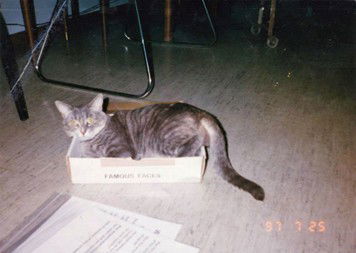
Tornie joins in as ADC clients play the “Famous Faces” game. July 25, 1997. Photo by Ann Prusinski. John Psiharis collection.
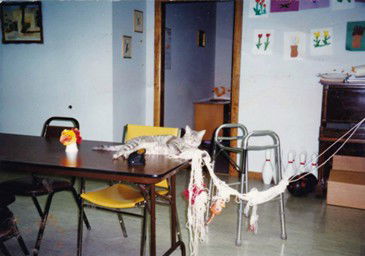
Tornie all tied up. Date unknown. John Psiharis collection.
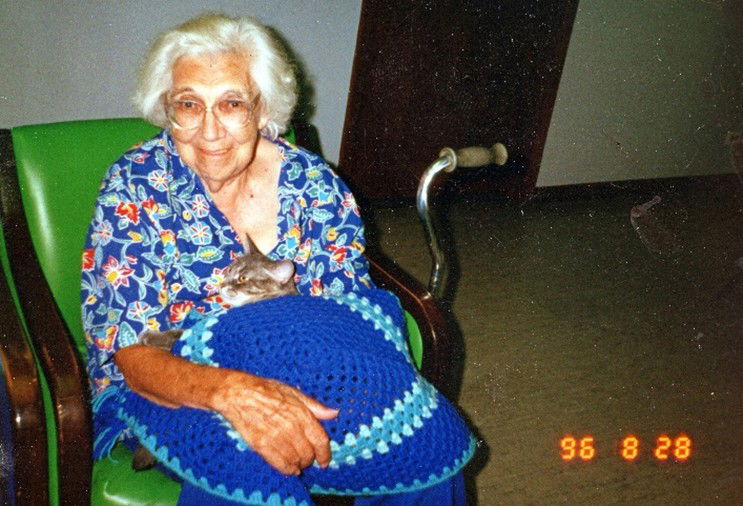
Pet therapy in action. Tornie snuggling with an ADC participant. August 28, 1996. Photo by Ann Prusinski. John Psiharis collection
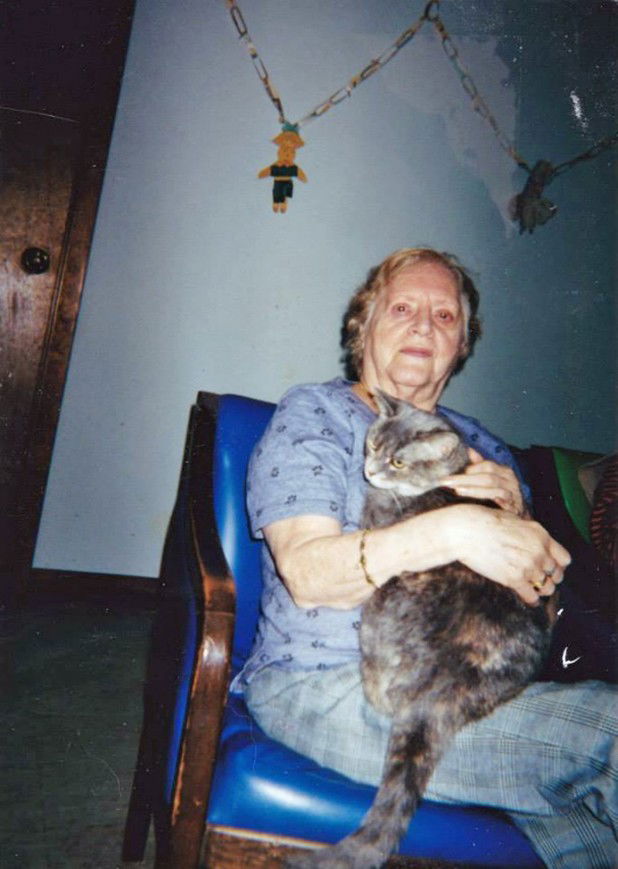
Tornie doing what she did best, cuddling. Date unknown. Photo by Ann Prusinski. John Psiharis collection.
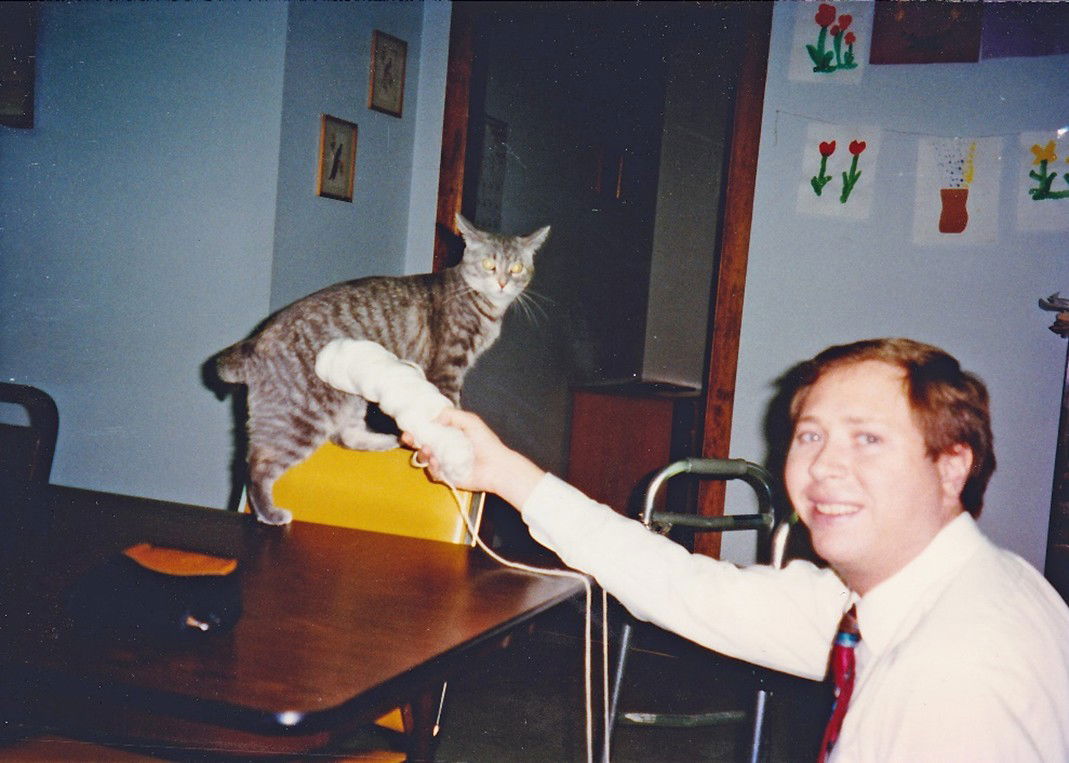
John Psiharis visiting with Tornie. Date unknown. John Psiharis collection.
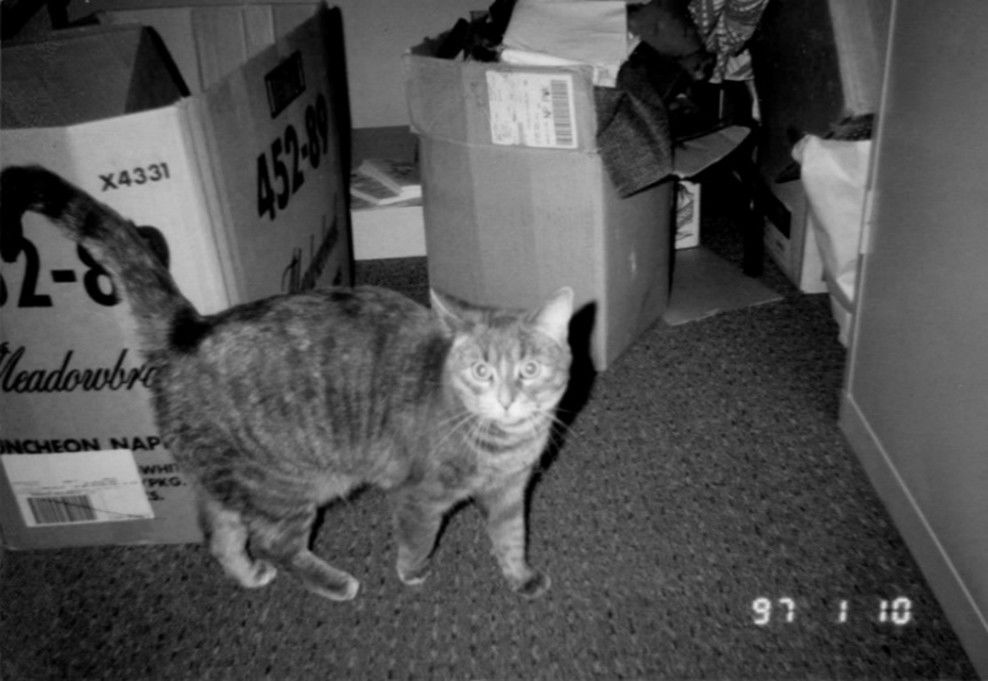
“Tornie the Tornado - the Good Girl,” at GACS. January 10, 1997. Photo by Ann Prusinski. John Psiharis collection.
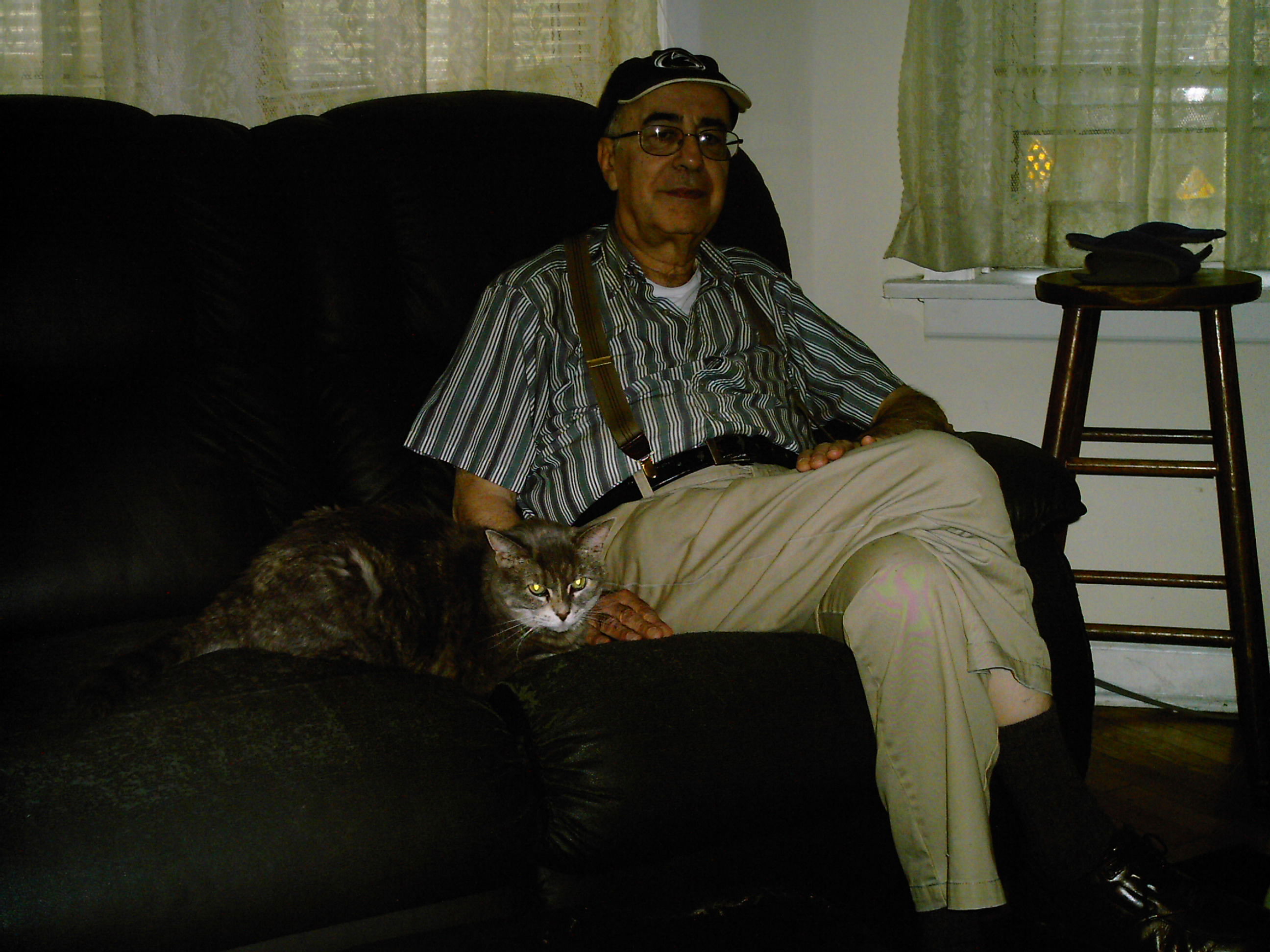
John Rassogianis visits with Tornie. September 16, 2006. John Psiharis collection.
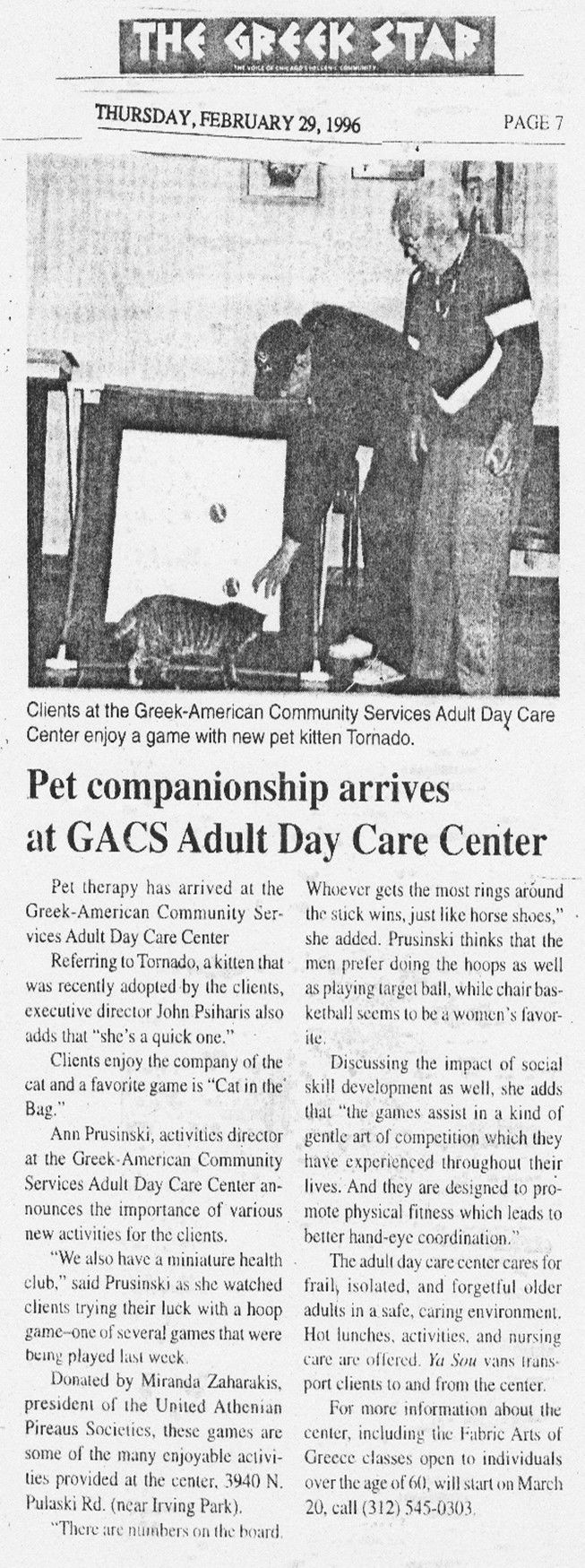
The Greek Star, February 29, 1996. John Psiharis collection.